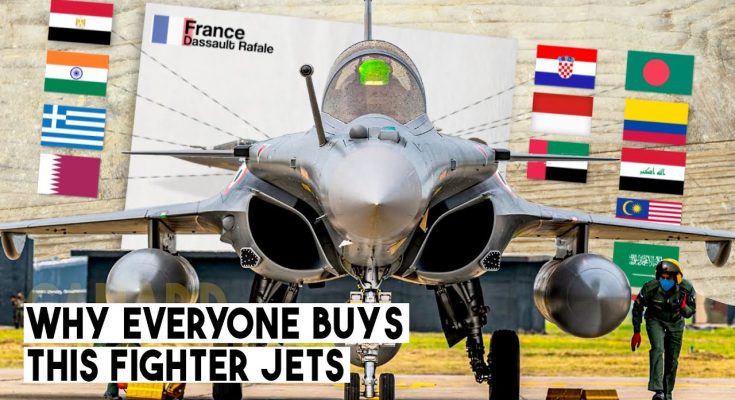The Dassault Rafale, a French-made multirole fighter aircraft, has gained international recognition and widespread adoption, becoming one of the most sought-after fighter jets in the global market. The reasons for its popularity stem from its exceptional capabilities, versatility, and affordability compared to other high-end fighter jets. As countries around the world look to modernize their air forces, the Rafale has emerged as a top contender due to its cutting-edge technology, combat performance, and proven track record.
Multirole Capabilities
One of the primary reasons why nations are flocking to buy the Rafale is its multirole versatility. Unlike some other aircraft that are designed for a specific type of mission (e.g., air superiority, strike, or reconnaissance), the Rafale is capable of performing a wide range of missions, including:
- Air-to-air combat: The Rafale is equipped with advanced radar and air-to-air missile capabilities to engage enemy aircraft at both short and long ranges.
- Ground attack: Its ability to carry a variety of precision-guided bombs, missiles, and rockets makes it highly effective in air-to-ground strike missions.
- Maritime operations: The Rafale is capable of conducting anti-ship warfare, with the Exocet missile system, and can also serve in naval operations, making it ideal for aircraft carriers.
- Intelligence, Surveillance, and Reconnaissance (ISR): The Rafale can perform reconnaissance and surveillance missions, collecting valuable intelligence on enemy positions.
This multirole functionality allows air forces to deploy the Rafale in virtually any combat scenario, making it an attractive option for countries seeking a highly versatile combat aircraft.
Advanced Technology and Performance
The Rafale is built with cutting-edge technology, including the Thales RBE2-AA radar and SPECTRA electronic warfare suite, which enhance its capabilities in a wide variety of operational environments. These advanced systems allow the Rafale to detect, track, and engage targets at great distances while evading enemy radar and missile systems.
The aircraft also boasts excellent aerodynamics, allowing it to maintain superior agility in combat situations. Its delta-wing design provides exceptional maneuverability, making it a formidable adversary in air-to-air combat. Additionally, the Rafale’s thrust-to-weight ratio and powerful engines contribute to its ability to perform high-speed maneuvers and quick take-offs and landings from various types of airstrips.
Another key feature of the Rafale is its reliability and low maintenance cost, which makes it a practical choice for countries looking to reduce operating expenses over the lifespan of the aircraft. Its design incorporates ease of serviceability, meaning that it requires less time on the ground for repairs and maintenance, a critical factor for military readiness.
Proven Combat Record
The Rafale has proven its effectiveness in actual combat situations, which is a key reason why many countries are choosing to buy it. The aircraft has been used in various military operations, including:
- Operation Harmattan (Libya, 2011): The Rafale played a significant role in the NATO-led mission, performing airstrikes and enforcing a no-fly zone.
- Operation Chammal (Iraq/Syria, 2014-present): The Rafale has been involved in counterterrorism operations, particularly in Syria and Iraq, where it has successfully carried out precision strikes against ISIS targets.
- Operation Barkhane (Sahel region, Africa): The Rafale has been part of France’s ongoing anti-terrorism operations in the Sahel region, demonstrating its capability to operate in diverse environments.
These real-world combat experiences have showcased the Rafale’s ability to operate in high-intensity conflict zones, under challenging conditions, and against sophisticated adversaries. The aircraft’s performance in these operations has greatly enhanced its reputation as a combat-ready and reliable platform.
Affordability and Global Appeal
While the Rafale is a high-performance fighter jet, it is often viewed as more affordable compared to its counterparts, such as the U.S.-made F-35 Lightning II or F-22 Raptor. This balance of advanced technology and cost-effectiveness has made the Rafale a favored choice for countries that want a top-tier fighter without breaking the bank. In addition, the Rafale’s relatively lower operating costs and long service life make it a financially sound investment for air forces with limited defense budgets.
The aircraft’s interoperability with various NATO and European systems has also played a role in its global appeal. Many countries, especially those in the Middle East and Asia-Pacific, have turned to the Rafale due to the aircraft’s compatibility with NATO-standard equipment and supply chains. Moreover, France’s longstanding history of military cooperation with countries like India, Qatar, and Egypt has led to strong diplomatic ties and, consequently, lucrative sales contracts.
Strong Diplomatic Ties and Exports
France has been able to successfully market the Rafale due to its strong diplomatic relations and military partnerships across the world. For instance, countries like India, Qatar, Egypt, and United Arab Emirates have signed deals to purchase the Rafale, driven by both the aircraft’s performance and the strategic importance of aligning with France on defense and geopolitical issues.
Conclusion
The Dassault Rafale stands out as one of the most powerful and versatile fighter aircraft in the world. Its multirole capabilities, advanced technology, proven combat record, and relatively affordable cost make it a preferred choice for many nations seeking a highly capable and reliable combat jet. With its strong export success and continued presence in global air forces, the Rafale is poised to remain a dominant force in the skies for years to come, further solidifying its place as one of the best fighter jets available today.



